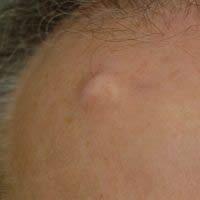Difference between Tumor and Cyst
Key difference: Tumors are unnatural lumps or growth formed by extra cells in the body. A tumor can be benign (not cancerous), pre-malignant (pre-cancerous), or malignant (cancerous). A cyst, on the other hand, is a common skin condition that occurs among people. A cyst is a closed capsule or sac-like structure. It is typically filled with liquid, semisolid or gaseous material.
 The human body is complex. At times, the cells of the body do not act in the way that they should. They may start to divide and grow uncontrollably. These extra cells tend to get stuck together and start forming small lumps or growths. Over time, more and more cells start to stick to these lumps causing them to further grow in size. These lumps or growths are called tumors or a neoplasm. These tumors may be solid or fluid-filled. However, a tumor does not equate to cancer. A tumor can be benign (not cancerous), pre-malignant (pre-cancerous), or malignant (cancerous).
The human body is complex. At times, the cells of the body do not act in the way that they should. They may start to divide and grow uncontrollably. These extra cells tend to get stuck together and start forming small lumps or growths. Over time, more and more cells start to stick to these lumps causing them to further grow in size. These lumps or growths are called tumors or a neoplasm. These tumors may be solid or fluid-filled. However, a tumor does not equate to cancer. A tumor can be benign (not cancerous), pre-malignant (pre-cancerous), or malignant (cancerous).
A cyst, on the other hand, is a common skin condition that occurs among people. A cyst is a closed capsule or sac-like structure. It is typically filled with liquid, semisolid or gaseous material.
 There are hundreds of types of cysts. They may appear just below the skin or inside the body connected to tissue or an organ. They vary in size from microscopic to the size of some team-sport balls. Large cysts can even displace internal organs. Skin cysts usually appear as an abnormal lump just below the skin and may or may not be painful. A cyst in the breasts may be noticeable when the breasts are examined by touching them and are often painful. Some cysts may not be noticeable or visible except under imaging systems. Cysts in the brain can cause headaches, as well as other symptoms.
There are hundreds of types of cysts. They may appear just below the skin or inside the body connected to tissue or an organ. They vary in size from microscopic to the size of some team-sport balls. Large cysts can even displace internal organs. Skin cysts usually appear as an abnormal lump just below the skin and may or may not be painful. A cyst in the breasts may be noticeable when the breasts are examined by touching them and are often painful. Some cysts may not be noticeable or visible except under imaging systems. Cysts in the brain can cause headaches, as well as other symptoms.
Only a person with efficient medical knowledge may be effectively able to diagnose a lump as a cyst or a tumor. Whether the cyst or tumor poses any danger to the person or not can only be known after certain tests. However, a general comparison between a cyst and a tumor follows:
|
|
Cyst |
Tumor |
|
Description |
A cyst is a closed sac, having a distinct membrane and division compared to the nearby tissue. It may contain air, fluids, or semi-solid material. |
Tumors are unnatural lumps or growth formed by extra cells in the body. These tumors may be solid or fluid-filled. Tumors are also called neoplasm. |
|
Occurrence |
Can occur anywhere in the body in people of any age. |
Tumors can affect any part of the body, but usually only the cancerous tumors tend to spread to other parts of the body. |
|
Types |
There are more than a hundred types. |
There are in fact over 200 different known cancers that afflict humans. |
|
Causes |
Tumors, genetic conditions, infections, a fault in an organ of a developing embryo, a defect in the cells, chronic inflammatory conditions, blockages of ducts in the body which cause a fluid build-up, a parasite, impact injury that breaks a vessel. |
Problems with the body's immune system can lead to tumors, as well as tobacco and alcohol usage, benzene and other chemicals and toxins, environmental toxins, excessive sunlight exposure, genetic problems, obesity, radiation, viruses, among others. |
|
Benign or malignant |
Most cysts are benign and are caused by plugged ducts or other natural body outlets for secretions. However, some cysts may be tumors and/or are formed inside tumors - these can be potentially malignant. |
A tumor can be benign (not cancerous), pre-malignant (pre-cancerous), or malignant (cancerous). Benign tumors are mostly harmless, but some may have slightly negative health effects, such as pushing against vital organs or blood vessels (known as "mass effect") or they may lead to overproduction of certain hormones. A pre-malignant tumor or a pre-cancerous tumor is a growth that is probably harmless at the moment but does have a significantly increased risk of cancer. This means that if the tumor is left untreated, it may lead to the conditions that may lead to cancer. A malignant tumor is a tumor that is considered to be cancer. In cancer, the cells divide and grow uncontrollably. However, instead of sticking together in a singular place, as in the case of a benign tumor, these cells go all over the place and create malignant tumors in various places. Hence, cancer is not just the presence of a single malignant tumor but many. |
|
Symptoms |
Abnormal lump just below the skin and may or may not be painful. |
Symptoms vary depending on the type and location of the tumor. Some tumors may not cause any symptoms. Some common symptoms include: chills, fatigue, fever, loss of appetite, malaise, night sweats, weight loss, etc. |
|
Detection |
Some may be discovered by imaging studies, such as x-ray, ultrasound, CT scan, etc. |
There are ways to detect the presence of tumors. These include the presence of certain signs and symptoms, screening tests, or medical imaging, including CT or MRI scan, blood tests, etc. The type of tumor can be diagnosed by microscopic examination of a tissue sample, also known as a biopsy. |
|
Treatments |
Cysts may go away by themselves, or must be surgically removed. Sometimes the fluid within a cyst can be drained by inserting a catheter or needle into it and collapsing it. |
Treatment varies based on: the type of tumor, whether it is cancerous or not, and the location of the tumor. Some tumors may not require treatment at all, while others may be required to be removed via surgery or treated via chemo or radiotherapy. |
Image Courtesy: skinblemishcare.wordpress.com, bellevue-dermatology.com









Add new comment